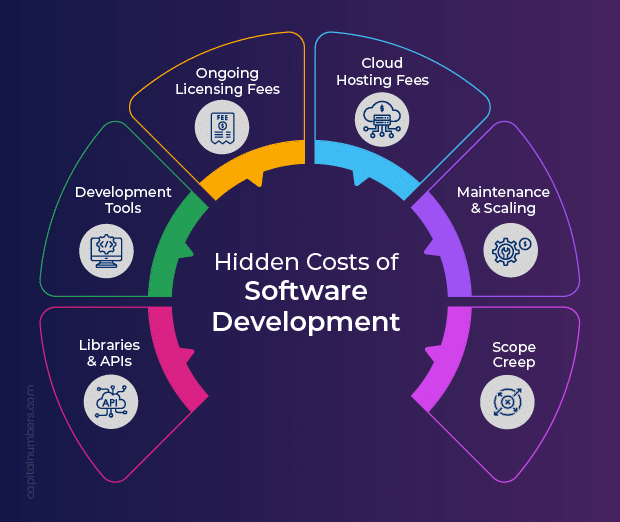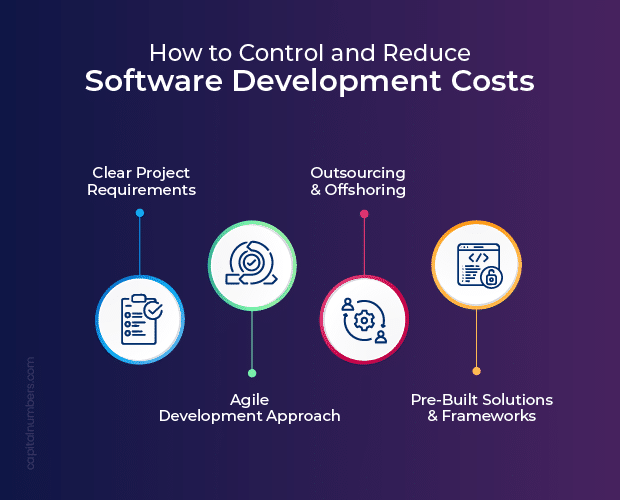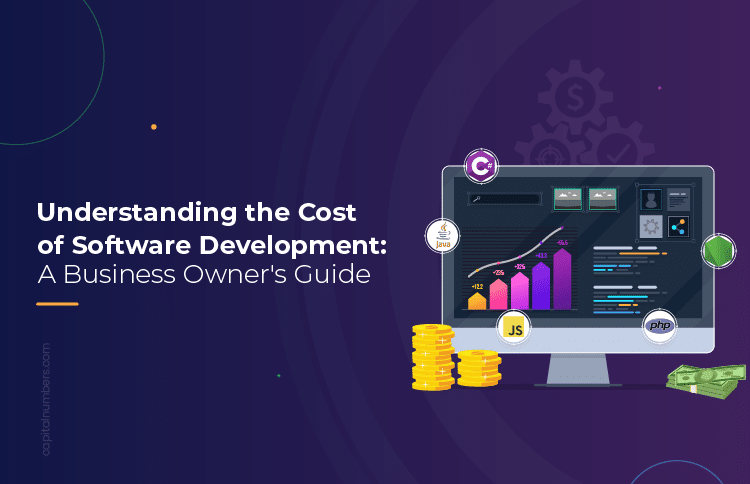Understanding the Cost of Software Development: A Business Owner’s Guide
Table of Contents
Understanding the cost of software development is essential for business owners, as it directly affects budget, timelines, and the final product’s success. It’s not just about finding the lowest cost option; it’s about balancing cost, quality, and project scope.
In this blog, you’ll learn about the key factors influencing software development costs. We’ll also explore hidden expenses and share strategies for managing and reducing them, enabling you to make well-informed financial decisions.
1. Scope and Complexity
The scope of a software development project refers to the breadth and depth of features, functionality, and goals it aims to achieve. This plays a critical role in determining development costs, as larger and more comprehensive projects require greater resources, time, and specialized expertise.
Small-scale projects, like a basic appointment scheduling app for a local service business or a mobile app for tracking employee attendance in a small company, have focused functionality and fewer dependencies, making them relatively cost-effective to develop.
In contrast, multi-module platforms like a full-featured e-commerce solution with customer management, inventory, analytics, and payment integrations require a broader skill set, more sophisticated technology, and greater coordination across teams, increasing both complexity and cost.
Similarly, an enterprise-level HR management system with integrations for payroll, performance tracking, and employee engagement tools is significantly more complex, demanding extensive resources and thereby raising development costs.
Business owners must carefully assess their requirements and set realistic goals that align with their budgets. This will enable them to achieve their objectives efficiently and cost-effectively.
You May Also Read: Discovery Phase: The First Step to Successful Software Projects
2. Technology Stack
The choice of technology stack – the combination of programming languages, frameworks, and tools used to develop software – directly impacts both the initial and long-term costs of a project.
Popular Languages and Frameworks:
Each programming language and framework is suited to different project needs. For instance, Python is widely used in data-heavy applications and machine learning solutions, while Node.js is preferred for fast, scalable server-side development. For front-end development, frameworks like React and Angular are popular due to their flexibility and strong community support. Each technology presents unique advantages, influencing development speed, efficiency, and overall cost.
Open-Source and Proprietary Technologies:
Open-source technologies (e.g., Python, Node.js, React) are generally free and offer extensive libraries that speed up development and reduce licensing costs. Proprietary technologies, however, often involve licensing fees and restrictions that can increase upfront costs, though they may offer specialized support or essential features for specific industries or projects.
The right tech stack also influences long-term costs, particularly in terms of scalability, maintenance, and adaptability to future needs.
You May Also Read: How to Choose Your Tech Stack?
3. Experience and Expertise of the Development Team
The expertise and experience level of developers directly affect the cost of a software development project.
- Junior vs. Senior Developers: Junior developers are often less expensive and suitable for routine tasks or less complex projects. However, they may require more supervision and produce work at a slower pace. Senior developers, on the other hand, come at a higher cost but can manage complex challenges more effectively, make faster decisions, and require less oversight, which can ultimately save time and reduce risks.
- Specialized Experts: Certain projects demand expertise in specific fields—such as machine learning, data security, or DevOps – which adds to the overall cost. Specialized experts are typically required for high-stakes projects where precision, scalability, and advanced functionality are essential.
Also, the structure and composition of the development team significantly impact the cost. Different roles, from full-stack developers to front-end/back-end specialists and designers, each come with unique skill sets and corresponding cost implications.
- Full-Stack Developers: Full-stack developers, like MERN stack developers, possess both front-end and back-end skills, offering a flexible, cost-effective solution for smaller projects or startups.
- Front-End/Back-End Specialists: Dedicated back-end or front-end developers often provide deeper expertise in their respective areas, which can improve the quality and performance of the final product.
- Dedicated UI/UX Designers: Adding dedicated UI/UX designers to the team increases costs. However, investing in quality design can drive better user engagement and retention, delivering long-term value.
By strategically balancing skill levels and team composition, business owners can build an effective team that meets both project needs and budget constraints.
4. Project Timeline
The timeline for a software development project directly affects its overall cost. Tight deadlines often require a larger team or overtime hours, which drive up expenses. Additionally, rushed work may result in increased costs later, as quicker development can lead to technical debt or quality issues that require fixes post-launch.
By contrast, a flexible timeline allows for an adaptive approach where the project can progress in stages, ensuring quality without incurring extra costs due to last-minute rushes. It also provides time for iterative improvements, thorough testing, and refinement, helping prevent costly fixes later.
Business owners should assess both immediate needs and long-term goals to select a timeline that balances speed with cost-efficiency, ensuring a high-quality outcome within budget.
5. Testing and Quality Assurance (QA)
Quality assurance (QA) is an essential part of the software development lifecycle, ensuring the product functions correctly, provides a positive user experience, and meets all specifications before launch.
Types of Testing: Functional, Usability, Performance, Security
Following is the list of different types of testing, each serving a unique purpose in ensuring the software’s quality, functionality, and security.
- Functional Testing: Verifies that each feature of the software works as intended, focusing on core functionality and ensuring users can interact with the application as expected.
- Usability Testing: Usability testing helps ensure that users can navigate the product smoothly, which is critical for user retention and satisfaction.
- Performance Testing: Performance testing assesses the software’s speed, stability, and responsiveness under different loads.
- Security Testing: Focuses on identifying vulnerabilities and securing the application against potential breaches.
Manual vs. Automated Testing: Pros, Cons, and Cost Implications
Choosing between manual and automated testing – or finding the right balance between both – depends on the specific needs and budget of the project.
- Manual Testing: Manual testing is ideal for user-driven scenarios, such as usability or exploratory testing, where the human perspective is essential. While it provides valuable insights, manual testing is labor-intensive and can be costly for large-scale or complex applications requiring numerous test cases.
- Automated Testing: Automated testing is highly efficient for routine, repetitive, or regression testing tasks. Though the initial setup cost for automated testing is higher, it reduces long-term testing costs by allowing tests to be run quickly and frequently, especially in projects requiring extensive testing.
In conclusion, testing and QA are vital to ensuring software quality, security, and performance. While robust QA practices add to development costs, they play a crucial role in preventing post-launch issues, building user trust, and safeguarding the product’s reputation.
6. Complexity of Integration
Integrating new software with existing systems or third-party applications is often a complex task that directly impacts project costs. Each integration point requires additional coding, configuration, and testing, adding time and expense to the project.
- API Integration: API integration allows different software systems to communicate and share data. For example, payment gateway, third-party shipping, live traffic map, etc.
- Legacy Systems and Data Migration: Integrating with outdated or legacy systems poses unique challenges, as these older systems may lack modern data standards or compatibility with newer software.
- ERP Integration: Integrating new software with an ERP requires extensive planning, precise data mapping, and rigorous testing to ensure accurate data synchronization across departments.
- CRM Integration: Integrating with a CRM requires careful handling to maintain data consistency, ensure user accessibility, and uphold data privacy standards, adding to the overall project cost.
Integration complexity can vary greatly depending on whether the project requires custom API development or can leverage plug-and-play solutions. The number and complexity of integration have a significant influence on software development costs.
7. Security Measures
Security measures are a vital component of software development, especially in industries handling sensitive or regulated data. Implementing robust security protocols requires specialized expertise, additional development time, and thorough testing, all of which contribute to increased project costs.
- Encryption: Encryption protects data by converting it into unreadable code, accessible only to authorized users, ensuring data privacy and security.
- Authentication and Access Control: Features like multi-factor authentication (MFA) and single sign-on (SSO) verify user identities and control access to different parts of the application, strengthening overall security.
- Network Security and Firewalls: Network security tools, such as firewalls, monitor incoming and outgoing traffic to prevent unauthorized access, safeguarding the system from external threats.
Software development costs are generally higher in sectors like finance, healthcare, and e-commerce, as these industries require advanced security measures to comply with regulatory standards and protect against potential cyber threats.
8. Compliance and Regulations
Complying with regulations requires specialized knowledge, additional development resources, and rigorous testing to ensure the software meets all necessary standards. This often requires consulting with compliance experts, building security protocols, and conducting thorough audits, all of which contribute to higher development expenses.
Different industries are governed by specific regulatory frameworks that dictate how data should be collected, processed, and protected.
- GDPR (General Data Protection Regulation): GDPR applies to businesses handling EU citizen data, mandating strict data privacy and protection measures. Compliance involves obtaining explicit user consent, providing data access and deletion options, and securing personal data from unauthorized access.
- HIPAA (Health Insurance Portability and Accountability Act): HIPAA regulates the handling of patient data in healthcare, requiring secure data storage, encrypted data transmission, and restricted access to protected health information (PHI).
- PCI-DSS (Payment Card Industry Data Security Standard): PCI-DSS applies to businesses handling payment card information, requiring secure storage, transmission, and processing of cardholder data. Compliance includes implementing secure payment gateways, encrypting card data, and conducting regular vulnerability assessments.
Meeting these regulatory standards requires extra development, testing, and documentation to align software with legal requirements. Non-compliance, however, can result in substantial fines, legal liabilities, and reputational harm, making these upfront investments essential.
9. Geographical Location (Offshore, Onshore, Nearshore)
The geographical location of a software development team significantly impacts project costs. When deciding where to source your developers, you’ll generally have three options: offshore, onshore, and nearshore. Each option has different pricing structures, strengths, and types of projects they are best suited for. Here’s a quick breakdown:
- Offshore (Distant Countries)
- Cost: This is the most cost-effective option. Offshore developers often come from countries with lower labor costs, offering excellent value for businesses on a tight budget. Additionally, offshore outsourcing provides access to a vast, diverse talent pool, allowing companies to find specialized skills and scale teams flexibly without compromising on quality.
- Best for: Projects that do not require in-person meetings or strict compliance with local data safeguarding regulations can greatly benefit from this model.
- Onshore (Same Country)
- Cost: This is usually the most expensive option. Hiring developers within your own country generally comes with higher labor costs but also easier communication and time zone alignment.
- Best for: Complex projects requiring close collaboration, high security, or a lot of face-to-face interaction, like government projects, sensitive data work, or large enterprise projects.
- Nearshore (Nearby Countries)
- Cost: Nearshore teams can be slightly cheaper than onshore, as these developers often reside in countries with lower living costs but are still relatively close. You’ll save on labor costs without sacrificing much in terms of communication or time zone overlap.
- Best for: Projects that benefit from time zone alignment, allowing for quicker communication and collaboration, but do not prioritize significant cost savings, are well-suited for the nearshore option.
By aligning your project needs with the right geographical option, you can manage costs effectively while ensuring you get the right talent and resources for your project.
You May Also Read: How to Manage Your Offshore Software Development Team Efficiently
10. Hidden Costs of Software Development

While many costs of software development are visible and planned, there are often hidden expenses that can add up over the project’s life cycle. Key areas to watch include licensing fees, infrastructure, and scope management.
- Third-Party Libraries and APIs: Many projects use third-party libraries and APIs to streamline development. Although some are open-source and free to use, others require licensing fees, which vary depending on the tool and usage.
- Development Tools: Specialized tools for coding, testing, and deployment – such as IDEs (Integrated Development Environments), code repositories, and QA tools—often have associated subscription or licensing costs.
- Ongoing Licensing Fees: In some cases, software licenses are subscription-based and require renewal over time, which can become a recurring expense.
- Cloud Hosting Fees: Platforms such as AWS, Azure, and Google Cloud provide scalable, on-demand cloud infrastructure but come with variable costs based on usage. Fees may include data storage, processing power, bandwidth, and other resource-based charges.
- Ongoing Maintenance and Scaling Costs: As the user base grows, applications require scaling to maintain performance, leading to increased infrastructure costs. Additionally, maintaining server uptime, handling traffic spikes, and performing routine updates are ongoing expenses that need to be budgeted for in the long term.
- Impact of Scope Creep: Adding new features or modifying requirements mid-project requires additional development time, testing, and resources, driving up costs.
Understanding these hidden costs is essential for accurate budgeting and successful project management.
How to Control and Reduce Software Development Costs

Effective cost control is essential for any software development project. The following strategies and best practices help manage expenses efficiently while maximizing project value.
- Clear Project Requirements: Establishing clear, detailed project requirements from the outset is one of the most effective ways to control costs.
- Agile Development Approach: The Agile development approach uses iterative cycles, or “sprints,” to develop and refine project elements incrementally, making it ideal for controlling costs and remaining flexible as business needs evolve.
- Outsourcing and Offshoring: Outsourcing software development to lower-cost regions, or offshoring, can be a cost-effective solution for budget-conscious businesses.
- Using Pre-Built Solutions and Frameworks: Using pre-built solutions, frameworks, and open-source tools can cut development time and costs by providing tested functionality that developers can quickly customize, allowing them to focus on unique features instead of building from scratch.
These approaches not only help optimize budgets but also ensure that the development process remains efficient, flexible, and focused on delivering high-quality, sustainable software solutions.
You May Also Read: Balancing Cost & Quality in Software Development Outsourcing
Final Advice: Choosing the Right Development Partner
Selecting a software development company that truly understands your project’s unique needs and business objectives is crucial for a successful outcome. Find a partner with a strong history of delivering high-quality, flexible solutions and the ability to adjust their approach to fit your budget. The right team will work closely with you, helping you set clear priorities, find ways to save costs, and build a software solution that combines innovation with smart spending.
Ready to find the perfect development partner for your next project? Reach out today to explore how we can bring your vision to life with the ideal blend of expertise, flexibility, and cost-effectiveness.















